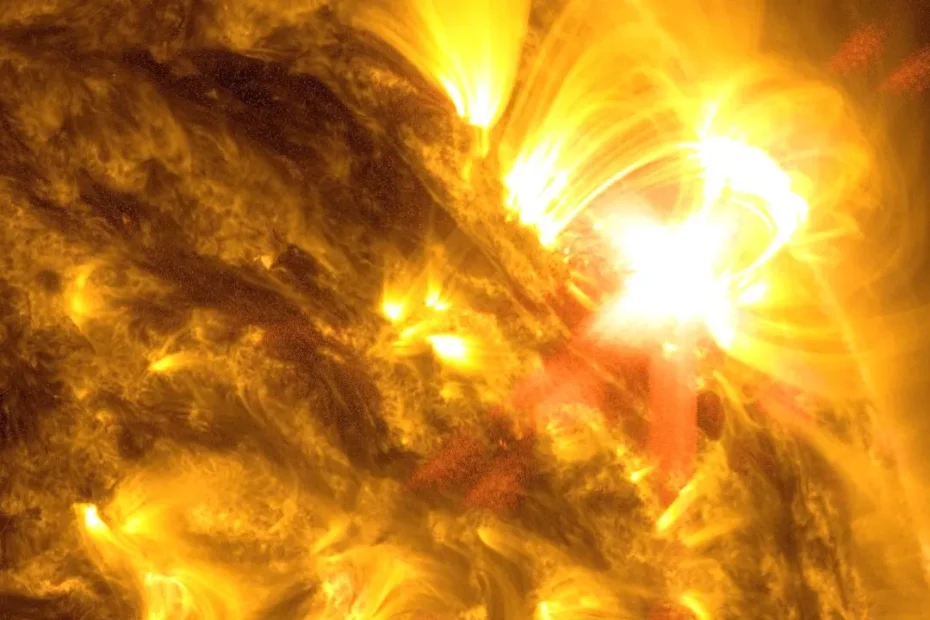Introduction
Few cosmic events are as dramatic—or as beautiful—as a solar flare. These eruptions on the Sun’s surface release colossal amounts of energy, equivalent to billions of nuclear bombs detonating simultaneously. Modern technology allows astronomers to capture these violent events in exquisite detail, producing high-resolution images that not only dazzle the public but also provide scientists with crucial data about our star’s behavior. But how exactly are these breathtaking images made, and what do they reveal about the Sun’s inner workings?
What Exactly Is a Solar Flare?
A solar flare is a sudden, intense burst of radiation originating from the Sun’s atmosphere. It occurs when magnetic energy, stored in the Sun’s tangled magnetic fields, is suddenly released.
- Location: Flares usually erupt in active regions near sunspots, where magnetic fields are especially strong and twisted.
- Energy Output: A powerful flare can release energy equivalent to 10⁶ times the annual energy consumption of Earth.
- Radiation Spectrum: Flares emit radiation across the electromagnetic spectrum—from radio waves to gamma rays.
- Classification: NASA categorizes flares into classes (A, B, C, M, X) based on X-ray brightness, with X-class being the most powerful.
Often, flares are associated with coronal mass ejections (CMEs), which hurl billions of tons of solar plasma into space. These can interact with Earth’s magnetic field, causing geomagnetic storms and dazzling auroras, but also potentially disrupting satellites and power grids.
The Science Behind Solar Flares
At the core of every solar flare is magnetic reconnection—a process where twisted magnetic field lines snap, realign, and release enormous amounts of energy. This sudden reconfiguration accelerates charged particles (electrons and protons), heating plasma to tens of millions of degrees Kelvin.
The result is a multi-layered phenomenon:
- Chromosphere brightening: The lower solar atmosphere glows intensely.
- X-ray and UV bursts: High-energy photons are released instantly.
- Plasma loops: Glowing arcs of plasma trace the restructured magnetic fields, visible in extreme ultraviolet (EUV) and X-ray wavelengths.
These processes make flares not just energetic, but visually stunning when captured with the right instruments.
How High-Resolution Images of Solar Flares Are Captured
Capturing a flare is no small feat. The Sun’s brightness and variability require specialized instruments, often in space. Here’s how astronomers do it:
1. Specialized Space Telescopes
Earth’s atmosphere blocks most high-energy light, so space-based observatories are essential. Instruments such as:
- NASA’s Solar Dynamics Observatory (SDO): Provides continuous, full-disk images of the Sun in multiple ultraviolet and extreme ultraviolet wavelengths, with a resolution up to 0.6 arcseconds per pixel.
- Hinode (JAXA/NASA/ESA mission): Focuses on high-resolution X-ray and optical observations of solar activity.
- Solar Orbiter (ESA/NASA): Moves closer to the Sun than Earth, giving unprecedented detail and polar views.
These spacecraft observe the Sun at wavelengths invisible to the human eye, later translating the data into images.
2. Multi-Wavelength Imaging
Solar flares emit light across the spectrum, and each wavelength tells a different story:
- Visible light: Sunspots and white-light flares.
- Ultraviolet (UV) & Extreme Ultraviolet (EUV): Hot plasma loops and the solar corona.
- X-rays: The most energetic particles and the flare’s initial blast.
Combining these wavelengths creates composite images, revealing different layers of the Sun’s atmosphere.
3. Adaptive Optics and Image Processing
For ground-based solar observatories (such as the Daniel K. Inouye Solar Telescope in Hawaii), adaptive optics correct distortions caused by Earth’s turbulent atmosphere, sharpening the image.
Raw data from space and ground observatories is then processed:
- Noise is removed.
- False-color rendering is applied to wavelengths beyond human vision (for instance, EUV might be colored in gold or blue).
- Time-lapse sequences are generated to show flare evolution dynamically.
The final result is both scientifically precise and visually striking.
4. High-Cadence Monitoring
Solar flares unfold quickly—sometimes in just minutes. Instruments like SDO take images every 12 seconds, creating near-continuous coverage. This high cadence ensures that no phase of the flare is missed, from ignition to decay.
Why High-Resolution Images Matter
While they are undeniably stunning, these images serve a vital scientific purpose:
- Space Weather Forecasting: By studying flare mechanisms, scientists can better predict solar storms that may threaten satellites, astronauts, and power grids.
- Testing Physics Models: Observing magnetic reconnection in action helps refine theories of plasma physics.
- Understanding Stellar Activity: The Sun is a laboratory for understanding flare behavior on other stars, which often produce even more powerful “superflares.”
- Public Engagement: Vivid solar images inspire awe, increasing public interest in space science and funding for future missions.
Challenges in Imaging Solar Flares
- Brightness Contrast: Flares are extremely bright, often saturating detectors if not carefully managed.
- Radiation Hazards: Instruments in space must be shielded against the very radiation they are designed to observe.
- Sheer Scale: Features can span hundreds of thousands of kilometers, requiring wide-field views while preserving fine detail.
The Future of Solar Flare Imaging
Upcoming missions and telescopes promise even greater clarity:
- DKIST Telescope: Already producing some of the sharpest ground-based solar images ever.
- Parker Solar Probe: Flying closer to the Sun than any mission before, directly sampling solar wind near flare zones.
- Next-generation AI Processing: Machine learning is increasingly used to enhance flare detection and automate image reconstruction.
With these advances, future images of solar flares will be sharper, faster, and more informative—transforming our understanding of solar activity.
Conclusion
Solar flares are both destructive and mesmerizing. Thanks to high-resolution imaging, humanity can witness the Sun’s raw power in ways unimaginable just a few decades ago. These images are not mere space photography—they are windows into the fundamental physics of plasma, magnetism, and energy release. Every flare captured sharpens our knowledge of the star that sustains life on Earth, while reminding us of the Sun’s awe-inspiring, and sometimes dangerous, power.
